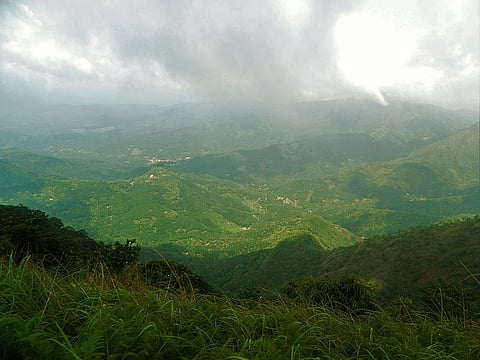
- Destinations
- Experiences
- Stay
- What's new
- Celebrating People
- Responsible Tourism
- CampaignsCampaigns
- Subscribe
- Buy Now

The Cardamom Hills, also known as Yela Mala, are located in the Idukki district of Kerala, in southern India. In Malayalam, “Yela” means cardamom and “Mala” means hills, directly referring to the region’s long-standing association with cardamom cultivation. The Cardamom Hills are also part of the Western Ghats, a UNESCO World Heritage Site, recognised for its biodiversity and ecological significance.
Cardamom is often referred to as the “queen of spices” and is one of the most widely recognised spices globally. The spice is a staple in both domestic and international kitchens, used in everything from teas and curries to desserts. The name "cardamom" saw a surge in online visibility, due to “Mr. Cardamom,” the stage name of wildly popular New York City politician Zohran Mamdani. His song “#1 Spice,” featured in the soundtrack of the Disney film Queen of Katwe—directed by his mother, Mira Nair—is a playful tribute to the spice, with lyrics like: “Bring the flavour to the fish, bring the flavour to the rice / Who’s the number-one spice?”
In India, Kerala—especially the Idukki district—produces a significant portion of the country’s cardamom. The Cardamom Hill Reserves (CHR) in Idukki serve as a major cultivation area. Traditionally, many varieties such as Mysore Vazhukka, Kanipparamban, Elam Rani, and Palakkudi were grown here. However, gradually, the Njallani variety became dominant due to its higher yield.
Several reports and experts have flagged environmental problems caused by intensive cardamom farming in the Indian Cardamom Hills. Over the past 30 years, rising temperatures have made pest and disease outbreaks more common. Soil conditions encourage pests, leading to increased pesticide use that can harm both the environment and human health. Water use for irrigation has led to groundwater depletion. Climate change is also altering rainfall and temperature patterns, making farming more challenging. Additionally, heavy tree pruning and widespread use of plastic shade nets have changed the forests, reducing plant diversity and transforming the natural rainforest landscape.
The area provides excellent opportunities for guided nature walks and treks through the hills and forests. These treks allow travelers to spot wildlife, learn about local flora and fauna, and support local guides, promoting ethical and sustainable tourism practices.
The Idukki district in Kerala is home to several indigenous tribes, including the Mannan, Muthuvan, Paliyan, Urali, Malayarayan, Malapulayan, and Ulladan. These communities have a rich cultural heritage closely connected to the Cardamom Hills. Visitors can engage with local communities to learn about their traditions and enjoy local cuisine, enhancing their cultural experience.
At Idukki Wildlife Sanctuary, travellers can explore nature through the sanctuary’s trails winding through forests, grasslands, and mountain ridges, offering chances to spot native species. Visitors may see elephants, deer, bison, and rare birds like the Malabar grey hornbill. As a protected area, the sanctuary requires respectful behaviour—travellers are encouraged to follow eco-friendly practices, avoid littering, and maintain a safe distance from wildlife to help preserve its fragile ecosystem.
Sustainable farming and responsible resource use are essential for maintaining cardamom cultivation and preserving the ecological health of the Cardamom Hill Reserve in Idukki. The Kerala State Biodiversity Board (KSBB) had proposed efforts to restore the region’s damaged ecosystem, with a focus on promoting organic cardamom farming to reduce reliance on harmful chemical pesticides. Travellers visiting the CHR can explore lush plantations, especially during the harvest season from October to February. Guided visits with local farmers offer a deeper understanding of cultivation practices, as well as the cultural significance of cardamom in the region’s economy and heritage.
Visitors to Periyar National Park and Wildlife Sanctuary, also known as Periyar Tiger Reserve, are encouraged to explore the area responsibly, respecting its fragile ecosystem and diverse wildlife. Located in Kerala, this protected area is known for its rich biodiversity and varied landscapes, including tropical evergreen and deciduous forests, grasslands, and Periyar Lake. The sanctuary is home to 35–40 tigers, along with elephants, leopards, sambar deer, wild boar, and Nilgiri tahrs. It also hosts bird species like the great Indian hornbill and jungle fowl, as well as reptiles and endemic fish. Responsible travel supports conservation efforts and helps protect this vital habitat.
The nearest airport to Idukki is Cochin International Airport (COK), which is approximately 100-130 km away. The closest railway stations are Ernakulam South (ERS) and Kottayam (KTYM), located around 100 km and 114 km away, respectively.
The best time to visit Idukki, Kerala, is from October to February during the winter season. This period offers pleasant weather with temperatures ranging from 15°C to 25°C, making it ideal for sightseeing and outdoor activities. The monsoon season (June to September) brings heavy rainfall, which can disrupt travel plans.
Munnar, about 24–43 km from Idukki, is home to Eravikulam National Park, famous for the endangered Nilgiri Tahr, as well as the scenic Cheeyappara and Attukad waterfalls. Thekkady, located 27–46 km away, is known for Periyar National Park, offering diverse wildlife experiences. Vagamon, just 18 km from Idukki, is popular for paragliding and nature walks. Kodaikanal, 71 km away, is a cool hill station, while Kochi, 71–82 km from Idukki, is a historic port city featuring colonial architecture, vibrant spice markets, and rich cultural attractions.
